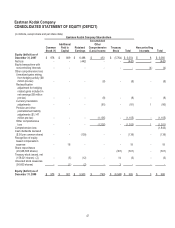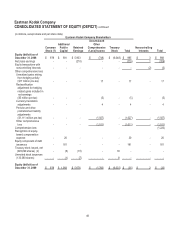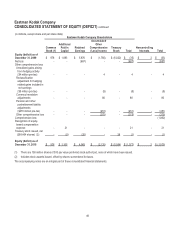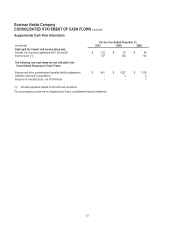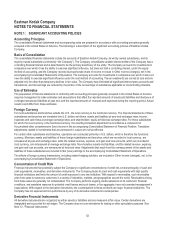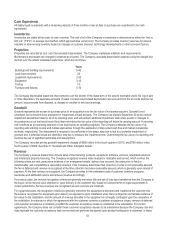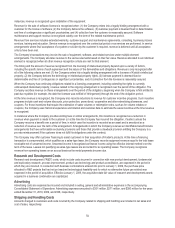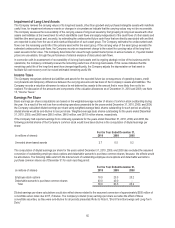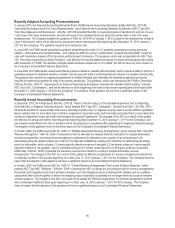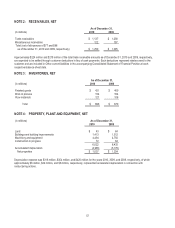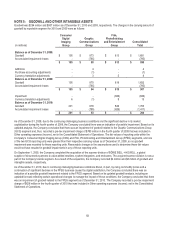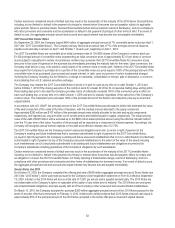Kodak 2010 Annual Report Download - page 54
Download and view the complete annual report
Please find page 54 of the 2010 Kodak annual report below. You can navigate through the pages in the report by either clicking on the pages listed below, or by using the keyword search tool below to find specific information within the annual report.52
Eastman Kodak Company
NOTES TO FINANCIAL STATEMENTS
NOTE 1: SIGNIFICANT ACCOUNTING POLICIES
Accounting Principles
The consolidated financial statements and accompanying notes are prepared in accordance with accounting principles generally
accepted in the United States of America. The following is a description of the significant accounting policies of Eastman Kodak
Company.
Basis of Consolidation
The consolidated financial statements include the accounts of Eastman Kodak Company, its wholly owned subsidiaries, and its
majority owned subsidiaries (collectively “the Company”). The Company consolidates variable interest entities if the Company has a
controlling financial interest and is determined to be the primary beneficiary of the entity. The Company accounts for investments in
companies over which it has the ability to exercise significant influence, but does not hold a controlling interest, under the equity
method of accounting, and the Company records its proportionate share of income or losses in Other income (charges), net in the
accompanying Consolidated Statements of Operations. The Company accounts for investments in companies over which it does not
have the ability to exercise significant influence under the cost method of accounting. These investments are carried at cost and are
adjusted only for other-than-temporary declines in fair value. The Company has eliminated all significant intercompany accounts and
transactions, and net earnings are reduced by the portion of the net earnings of subsidiaries applicable to noncontrolling interests.
Use of Estimates
The preparation of financial statements in conformity with accounting principles generally accepted in the United States of America
requires management to make estimates and assumptions that affect the reported amounts of assets and liabilities and disclosure of
contingent assets and liabilities at year end, and the reported amounts of revenues and expenses during the reporting period. Actual
results could differ from those estimates.
Foreign Currency
For most subsidiaries and branches outside the U.S., the local currency is the functional currency. The financial statements of these
subsidiaries and branches are translated into U.S. dollars as follows: assets and liabilities at year-end exchange rates; income,
expenses and cash flows at average exchange rates; and shareholders’ equity at historical exchange rates. For those subsidiaries
for which the local currency is the functional currency, the resulting translation adjustment is recorded as a component of
Accumulated other comprehensive (loss) income in the accompanying Consolidated Statement of Financial Position. Translation
adjustments related to investments that are permanent in nature are not tax-effected.
For certain other subsidiaries and branches, operations are conducted primarily in U.S. dollars, which is therefore the functional
currency. Monetary assets and liabilities of these foreign subsidiaries and branches, which are recorded in local currency, are
remeasured at year-end exchange rates, while the related revenue, expense, and gain and loss accounts, which are recorded in
local currency, are remeasured at average exchange rates. Non-monetary assets and liabilities, and the related revenue, expense,
and gain and loss accounts, are remeasured at historical rates. Adjustments that result from the remeasurement of the assets and
liabilities of these subsidiaries are included in Net (loss) earnings in the accompanying Consolidated Statement of Operations.
The effects of foreign currency transactions, including related hedging activities, are included in Other income (charges), net, in the
accompanying Consolidated Statement of Operations.
Concentration of Credit Risk
Financial instruments that potentially subject the Company to significant concentrations of credit risk consist principally of cash and
cash equivalents, receivables, and derivative instruments. The Company places its cash and cash equivalents with high-quality
financial institutions and limits the amount of credit exposure to any one institution. With respect to receivables, such receivables
arise from sales to numerous customers in a variety of industries, markets, and geographies around the world. Receivables arising
from these sales are generally not collateralized. The Company performs ongoing credit evaluations of its customers’ financial
conditions, and maintains reserves for potential credit losses and such losses, in the aggregate, have not exceeded management’s
expectations. With respect to the derivative instruments, the counterparties to these contracts are major financial institutions. The
Company has not experienced non-performance by any of its derivative instruments counterparties.
Derivative Financial Instruments
All derivative instruments are recognized as either assets or liabilities and are measured at fair value. Certain derivatives are
designated and accounted for as hedges. The Company does not use derivatives for trading or other speculative purposes. See
Note 12, “Financial Instruments.”







